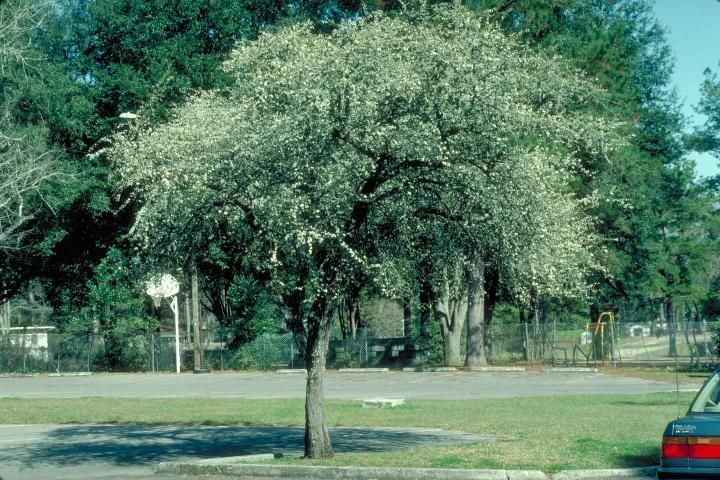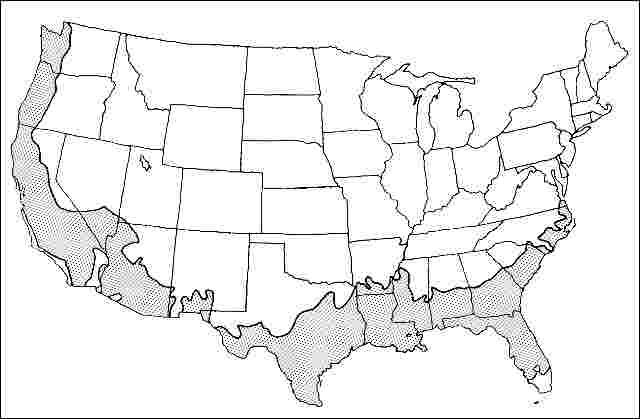Introduction
A native of the woods of the southeastern United States, Flatwoods Plum is a round-topped, deciduous tree, reaching 20 feet in height with a 15-foot spread, that is most often planted for its spectacular display of blooms. It may look a little ragged in winter. In late February, before the two-inch-long, finely serrate leaves appear, these small trees take on a white, billowy, almost cloud-like appearance when they are clothed in the profuse, small, white flower clusters. These half-inch blooms are followed by one-inch-long, edible, purple fruits which vary in flavor from very tart to sweet. These plums are very attractive to various forms of wildlife.

Credit: Ed Gilman
General Information
Scientific name: Prunus umbellata
Pronunciation: PROO-nus um-bell-AY-tuh
Common name(s): Flatwoods Plum
Family: Rosaceae
USDA hardiness zones: 8A through 9B (Fig. 2)
Origin: native to North America
Invasive potential: little invasive potential
Uses: deck or patio; specimen; street without sidewalk; parking lot island < 100 sq ft; parking lot island 100-200 sq ft; parking lot island > 200 sq ft; tree lawn 3-4 feet wide; tree lawn 4-6 feet wide; tree lawn > 6 ft wide; highway median; Bonsai; container or planter
Availability: somewhat available, may have to go out of the region to find the tree

Description
Height: 12 to 20 feet
Spread: 12 to 20 feet
Crown uniformity: irregular
Crown shape: round
Crown density: moderate
Growth rate: moderate
Texture: fine
Foliage
Leaf arrangement: alternate (Fig. 3)
Leaf type: simple
Leaf margin: serrate, serrulate
Leaf shape: elliptic (oval), ovate
Leaf venation: pinnate, brachidodrome
Leaf type and persistence: deciduous
Leaf blade length: less than 2 inches
Leaf color: green
Fall color: yellow
Fall characteristic: not showy

Flower
Flower color: white/cream/gray
Flower characteristics: showy
Fruit
Fruit shape: round
Fruit length: .5 to 1 inch
Fruit covering: dry or hard
Fruit color: purple
Fruit characteristics: attracts birds; not showy; fruit/leaves not a litter problem
Trunk and Branches
Trunk/bark/branches: branches droop; not showy; typically one trunk; thorns
Pruning requirement: little required
Breakage: resistant
Current year twig color: brown
Current year twig thickness: thin
Wood specific gravity: unknown
Culture
Light requirement: full sun, partial sun or partial shade
Soil tolerances: clay; sand; loam; slightly alkaline; acidic; well-drained
Drought tolerance: moderate
Aerosol salt tolerance: none
Other
Roots: not a problem
Winter interest: no
Outstanding tree: no
Ozone sensitivity: sensitive
Verticillium wilt susceptibility: susceptible
Pest resistance: resistant to pests/diseases
Use and Management
Flatwoods Plum thrives in full sun or partial shade on a wide variety of soils. When placed in sandy soil, it grows best with irrigation and some shade in the afternoon. Trees grow quickly when young but considerably slower when mature and bearing fruit. A bit weedy in growth habit, proper training and pruning can create an attractive specimen or small median strip or street tree, especially for planting beneath power lines or in other areas were overhead space is limited. Few root suckers form on this plant; many form on Prunus angustifolia .
Do not expect a row of them to form a uniform shape. The tree branches low to the ground making it a nice tall element in a backyard shrub border. Lower branches need to be removed in order to train as a street tree. Small-diameter, interior branches can be removed in winter to open up the crown for a more formal, attractive shape and habit. May live 30 to 40-years on a good site.
Propagation is by seed which must be stratified for several months to germinate.
Pests and Diseases
No pests or diseases are of major concern. Tent caterpillars occasionally infest Flatwoods Plum.